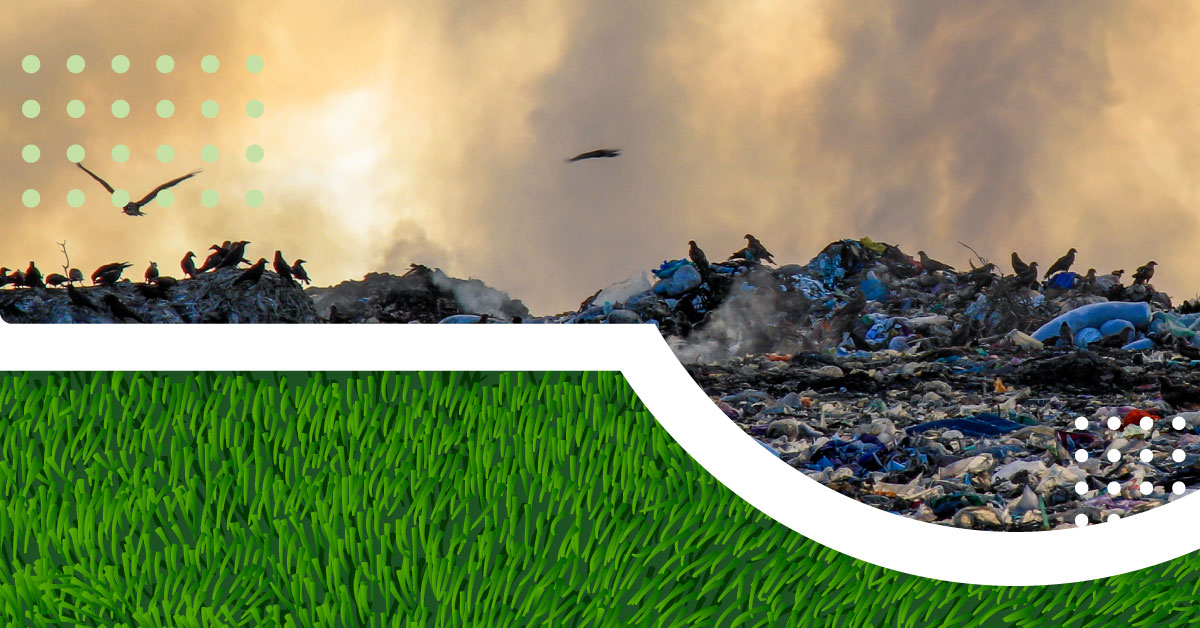Did You Know the Artificial Grass You Install Will End Up in a Landfill?

It’s easy to overlook how the little things add up. One plastic bag here, one tire there, and the next thing you know, you’re looking at vast landfills full of non-recyclable waste. Landfills have severe negative environmental impacts, from releasing methane gas into the atmosphere to destroying natural habitats for wildlife. Artificial grass is a big contributor to landfill waste. Artificial grass has been touted for years as a low-maintenance and sustainable alternative to real grass.
But, with the increasing popularity of artificial turf, it has become evident that it is anything but sustainable. There are approximately 13’000 artificial turf fields in the U.S. alone, which are generally 80’000 square-ft in size - with an estimated 10-year turf lifespan, that’s 15 to 20 dumpsters at 30 yards each ending up as landfill. As artificial turf providers and installers, it is our responsibility to work to reduce the amount of artificial grass that ends up in landfills.
The Problem With Artificial Grass
Artificial grass doesn’t break down in landfills, and that’s where it ends up when it is no longer wanted. Most artificial grass is made of synthetic materials, such as polypropylene, polyethylene, and nylon - are materials which are non-biodegradable and can take centuries to break down in landfills.
A solution emerged in 1991 to turn old tires into tire crumb and use them to create artificial turf to keep them out of landfills. However, fast forward to when most of these fields reached the end of their life span, and ended up in landfills all over again.
An Unsustainable Solution: The Fate of Rubber Crumb Fields
As PEER Science Policy Director Kyla Bennett, a former scientist with the U.S. Environmental Protection Agency, noted, rather than being recycled, turf fields and their rubber crumb infill are often dumped in abandoned lots, alleys, and even wetlands. “Crumb rubber fields do not solve a solid waste disposal problem; they merely delay and compound it,” Rubber crumb fields were considered an environmentally friendly solution because the material is non-toxic.
However, crumb rubber is made of recycled tires containing various hazardous chemicals and pollutants. When the rubber crumb breaks down, these hazardous pollutants can seep into the ground, air, and water, further putting our environment.
Artificial Grass Doesn’t Need to End Up in Landfills
Does Artificial Grass End up in Landfills?
Yes, but SealTuft has created the only 100% recyclable artificial grass that also provides an easy 1-step recyclable process. With an unmatched blend of durability, beauty and performance, our artificial turf solution is the only environmentally friendly choice with the best quality and installation for commercial or residential applications.
What Can We Do?
We must find a more sustainable and eco-friendly solution to the landfill issue and help where possible. The most practical solution for artificial grass and turf is to use materials that provide a more durable and eco-friendly alternative that doesn’t risk our environment and health. We owe it to ourselves and our planet to be more mindful of the environmental impacts of our decisions.
There are sustainable turf solutions that do not put our environment and health in jeopardy. We can educate our clients on the environmental impacts of artificial grass and encourage them to opt for more sustainable alternatives. By doing this, we ensure that we use the highest-quality turf available, extend the life of the turf we use, and make clients happy while protecting the environment.
Our Sustainable Artificial Grass Solution
SealTuft offers a sustainable artificial grass solution to clients. With over 20 years of experience in artificial grass and turf manufacturing, SealTuft’s synthetic grass solution is the only 100% and 1-Step recyclable synthetic grass in the market. We offer a wide variety of turf systems to match the needs of almost any customer project and dozens of different budget-friendly turf products that come in different colors, weights, heights, and sizes. As turf providers, we can help reduce the amount of artificial grass that ends up in landfills by using the highest-quality turf available and encouraging our clients to opt for recyclable options.
Key Takeaways:
- Artificial grass is a big contributor to landfill waste. Artificial grass has been touted for years as a low-maintenance and sustainable alternative to real grass. But, with the increasing popularity of synthetic turf, it has become evident that it is anything but sustainable.
- There are approximately 13’000 artificial turf fields in the U.S. alone, which are generally 80’000 square-ft in size - with an estimated 10-year turf lifespan, that’s 15 to 20 dumpsters at 30 yards each ending up as landfill.
- Most artificial grass is made of synthetic materials, such as polypropylene, polyethylene, and nylon - materials that are non-biodegradable and can take centuries to break down in landfills. The plastics in artificial turf contain toxic chemicals, such as lead and phthalates, which leach into the environment and can contaminate groundwater.
- SealTuft’s synthetic grass solution is the only 100% and 1-Step recyclable artificial grass in the market.
- We offer various turf systems to match the needs of almost any customer project and dozens of budget-friendly turf products that come in different colors, weights, heights, and sizes.
Take Action Now
If you want to reduce the amount of artificial grass in landfills and find sustainable alternatives, look no further. SealTuft has been providing successful artificial grass for installation and distribution since 1998. We can help create a more sustainable future for our planet by taking action now.
Our 20+ years of expertise in superior engineering, design, and manufacturing of our turf solutions, have produced a true evolution of the synthetic turf industry with SealTuft artificial turf. We can help create a more sustainable future for our planet by taking action now. Learn more today.
